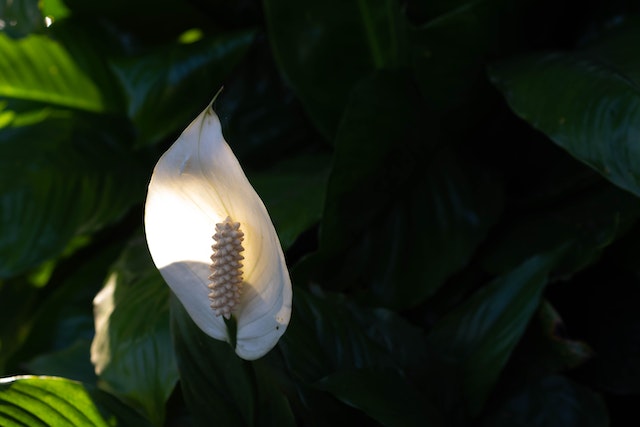Looking to keep your peace lily happy and thriving? Well, you’re in the right place! In this blog article, we’ll show you exactly how to fertilize your peace lily to ensure it stays healthy and vibrant. Whether you’re a seasoned plant enthusiast or just starting your green thumb journey, our simple and effective techniques will help you give your peace lily the nutrition it needs to flourish.
So, let’s dive right in and discover how to fertilize peace lily for flourishing foliage and stunning blooms.
How to Fertilize Peace Lily: A Comprehensive Guide
Peace lilies, with their beautiful white flowers and glossy green leaves, make an excellent addition to any indoor space. To ensure that your peace lily thrives and remains healthy, proper fertilization is essential.
In this guide, we will explore the best practices for fertilizing peace lilies, including the types of fertilizers to use, when and how often to fertilize, and additional tips for maintaining a thriving peace lily.
Understanding Peace Lily Nutritional Needs
Before diving into the specifics of how to fertilize a peace lily, it’s important to understand its nutritional needs. Like all plants, peace lilies require a balanced diet of macronutrients and micronutrients to grow and flourish.
The primary macronutrients necessary for their growth are nitrogen (N), phosphorus (P), and potassium (K). These nutrients help promote leaf development, root growth, and overall plant health.
Choosing the Right Fertilizer
When it comes to fertilizing peace lilies, choosing the right type of fertilizer is crucial. There are several options available, each with its own benefits. Here are some common types of fertilizers suitable for peace lilies:
1. Balanced Water-Soluble Fertilizers
Balanced water-soluble fertilizers, such as a 20-20-20 or 10-10-10 formula, are suitable for most peace lilies. These fertilizers contain equal ratios of nitrogen, phosphorus, and potassium, providing a well-rounded nutrient profile.
They are easy to use and quickly dissolve in water, making them readily available to the plant’s roots.
2. Slow-Release Granular Fertilizers
Slow-release granular fertilizers are another option for fertilizing peace lilies. These fertilizers are applied to the soil and release nutrients gradually over time.
They provide a steady supply of nutrients, reducing the risk of over-fertilization. Look for granular fertilizers with a balanced NPK ratio, such as 14-14-14 or 10-10-10.
3. Organic Fertilizers
For those who prefer organic options, organic fertilizers are a great choice. Organic fertilizers are derived from natural sources like compost, bone meal, or fish emulsion.
They release nutrients slowly and improve the overall soil health. Look for organic fertilizers specifically formulated for houseplants or indoor gardening.
Read More: About French Drain vs Dry Well: What To Choose?
Fertilizing Frequency and Timing
Peace lilies have relatively moderate fertilization needs compared to other houseplants. They typically require fertilization every two to four months during the growing season, which spans from spring to early fall.
Here’s a breakdown of the recommended fertilizing frequency based on the growth stage of your peace lily:
1. Newly Potted Peace Lily:
When you first bring home a new peace lily or repot an existing one, it’s best to wait for at least two to three months before applying any fertilizer. This allows the plant to acclimate to its new environment and reduces the risk of fertilizer burn.
2. Established Peace Lily:
Once your peace lily has settled into its new pot, you can start fertilizing. During the growing season, apply a diluted fertilizer solution every two to four months. Dilute the fertilizer according to the instructions on the packaging to avoid over-fertilization, as peace lilies are sensitive to excess salts.
3. Dormant Peace Lily:
During the winter months, peace lilies enter a dormant phase and require less frequent fertilization. You can reduce the fertilizing frequency to every four to six months during this period. However, if your peace lily shows signs of active growth, such as new leaves emerging, you may continue fertilizing at the regular frequency.
Proper Fertilizer Application
Now that you know when and what type of fertilizer to use, let’s discuss the proper application methods for fertilizing peace lilies:
1. Dilution:
Always dilute the fertilizer according to the packaging instructions before applying it to your peace lily. A general guideline is to use half the recommended strength for houseplants. Over-fertilizing can lead to nutrient burn, causing damage to the plant’s roots and leaves.
2. Watering:
Thoroughly water your peace lily a day or two before applying fertilizer. This helps ensure that the plant is well-hydrated and ready to absorb the nutrients effectively. Avoid fertilizing dry soil, as it may increase the risk of fertilizer burn.
3. Application Methods:
There are two primary methods for applying fertilizer to peace lilies:
- Top Dressing: Sprinkle the diluted fertilizer evenly on the soil surface around the base of the plant. Gently work the fertilizer into the top layer of soil, taking care not to damage the roots.
- Soil Drenching: Alternatively, you can apply the diluted fertilizer directly to the soil and slowly pour water through it to help distribute the nutrients evenly.
4. Additional Considerations:
Here are a few additional tips to keep in mind while fertilizing peace lilies:
- Avoid getting fertilizer on the leaves, as it can cause unsightly burn marks. If any fertilizer comes into contact with the foliage, gently wipe it off with a damp cloth.
- During the dormant period, reduce the fertilizer dosage to prevent the buildup of excess salts in the soil.
- Observe your peace lily for signs of over-fertilization, such as leaf burn or yellowing. If you notice any such symptoms, flush the soil with water to leach out the excess salts.
Fertilizing peace lilies is an important aspect of their care routine. By understanding their nutritional needs, choosing the right fertilizer, and following proper application techniques, you can ensure that your peace lily thrives and remains healthy.
Remember to fertilize during the growing season, dilute the fertilizer, and water the plant adequately before application. With the right approach, you can enjoy the lush beauty of your peace lily for years to come.
While fertilizing is crucial, don’t forget that other factors like light, temperature, and watering also play significant roles in maintaining a healthy peace lily. By providing a well-rounded care routine, you can create an environment where your peace lily can truly thrive.
Frequently Asked Questions (FAQs)
Peace lilies benefit from regular fertilizing during their active growing season, which is typically from spring to summer. As a general guideline, you can fertilize your peace lily once every month or every six weeks. Avoid overfertilization as it can cause leaf burn or other issues.
A balanced, water-soluble fertilizer with equal NPK (nitrogen, phosphorus, and potassium) ratio is ideal for peace lilies. Look for a fertilizer specifically formulated for houseplants or one that is suitable for foliage plants. Dilute the fertilizer according to the instructions on the package before applying it to your plant.
Yes, you can use organic fertilizers for your peace lily. Organic options like compost, worm castings, or liquid seaweed extract can provide nutrients to your plant. Just make sure to follow the instructions for application and adjust the dosage accordingly.
Fertilizing your peace lily during its active growing period, which is spring to summer, is the best time. Avoid fertilizing during the winter months when the plant’s growth slows down.
Applying fertilizer in the morning or early afternoon allows the plant ample time to absorb the nutrients before nightfall.
To fertilize your peace lily, dilute the fertilizer according to the instructions on the package. Water the plant with the diluted fertilizer solution, making sure to saturate the soil. Avoid getting the fertilizer on the leaves as it can cause burns. Discard any excess water that collects in the saucer after watering.
If you accidentally overfertilize your peace lily, you can flush the soil with water to help remove the excess nutrients. Place the plant in a sink or bathtub and allow water to flow through the soil for several minutes.
This will help leach out the excess fertilizer. Repeat the process a few times, ensuring the water drains properly.
Yes, there are a few signs that your peace lily may need fertilizer. If the leaves appear pale or yellowish, or if the plant’s growth is stunted, it may indicate a lack of nutrients.
However, it is important to rule out other factors such as inadequate light or improper watering before assuming it needs fertilizing.
Yes, you can use slow-release fertilizer for your peace lily. Slow-release fertilizers provide a steady supply of nutrients to the plant over an extended period.
Follow the instructions on the package for application, and remember to use it during the plant’s active growing season.
Read More: About The Difference: Aquaponics Vs. Polyaquaculture
Final Thoughts
To fertilize a peace lily, start by choosing a balanced, water-soluble fertilizer with a nitrogen-phosphorus-potassium (NPK) ratio of 20-20-20. Dilute the fertilizer according to the manufacturer’s instructions and apply it to the soil every two to four weeks during the plant’s active growing season. Be careful not to over-fertilize, as this can damage the peace lily. Always water the plant before applying fertilizer to avoid burning the roots.
Additionally, consider using organic fertilizers or replacing regular watering with diluted compost tea to provide nutrients naturally. Regular fertilization using these guidelines will promote healthy growth and vibrant blooms in your peace lily.
Auto Amazon Links: No products found.
Perfect Plants Christmas Tree Saver 8oz. | Easy Use Xmas Tree Preserver Food | Have Healthy Green Christmas Trees All Holiday Season
$9.97 (as of December 16, 2025 05:22 GMT +00:00 - More info- Product prices and availability are accurate as of the date/time indicated and are subject to change. Any price and availability information displayed on [relevant Amazon Site(s), as applicable] at the time of purchase will apply to the purchase of this product.
FirEver Pure Christmas Tree Food | Preserver Additive & Season Extender for Live Xmas Trees | Keep It Green, Reduce Needle-Drop | Miracle Freshness (8 oz)
$14.99 (as of December 16, 2025 05:22 GMT +00:00 - More info- Product prices and availability are accurate as of the date/time indicated and are subject to change. Any price and availability information displayed on [relevant Amazon Site(s), as applicable] at the time of purchase will apply to the purchase of this product.
Rocky Mountain Goods Christmas Tree Food - 8 oz Tree Preservative - Reduce Needle Drop - Greener Scent - Fir, Pine, Spruce Trees - Extend Tree Life
$9.95 (as of December 16, 2025 05:22 GMT +00:00 - More info- Product prices and availability are accurate as of the date/time indicated and are subject to change. Any price and availability information displayed on [relevant Amazon Site(s), as applicable] at the time of purchase will apply to the purchase of this product.
EZMeetU Christmas Tree Watering Funnel, 47 Inch Flower Shape Adjustable 6 Section Design, Christmas Tree Watering System, Christmas Tree Waterer, Long Funnel Wide Opening Reusable, Plant Watering Tool
$16.99 (as of December 16, 2025 05:22 GMT +00:00 - More info- Product prices and availability are accurate as of the date/time indicated and are subject to change. Any price and availability information displayed on [relevant Amazon Site(s), as applicable] at the time of purchase will apply to the purchase of this product.
VICAMB 39.3 Inch Christmas Tree Watering Funnel,Christmas Tree Watering System Device,Long Tree Watering Funnel Spout for Indoor Outdoor Xmas Tree
$17.99 (as of December 16, 2025 05:22 GMT +00:00 - More info- Product prices and availability are accurate as of the date/time indicated and are subject to change. Any price and availability information displayed on [relevant Amazon Site(s), as applicable] at the time of purchase will apply to the purchase of this product.
Snow Joe Premium Enviro Blend Ice Melt, Green-Coated Deicer Crystals, 50 lb - Safer Melter for Vegetation, Concrete & Metals w/ Anti-Corrosion Calcium Magnesium Acetate
$32.97 (as of December 12, 2025 19:27 GMT +00:00 - More info- Product prices and availability are accurate as of the date/time indicated and are subject to change. Any price and availability information displayed on [relevant Amazon Site(s), as applicable] at the time of purchase will apply to the purchase of this product.
Muddy Mat® Shown on TV Super Absorbent Microfiber Dog Door Mat for Muddy Paws, Non-Slip Washable Pet Rug, Quick Dry Chenille Entryway Carpet, Machine Washable Indoor Outdoor mat, Grey 30"x19"
$24.95 (as of December 12, 2025 19:27 GMT +00:00 - More info- Product prices and availability are accurate as of the date/time indicated and are subject to change. Any price and availability information displayed on [relevant Amazon Site(s), as applicable] at the time of purchase will apply to the purchase of this product.
ivtivfu Rolling Grill Basket, Removable Wooden Handle, 304 Stainless Steel, Nesting BBQ Tools, Smoker Grilling Accessories for Vegetable, Outdoor Cooking Camping, Birthday Gifts for Men Dad Husband
$25.99 (as of December 12, 2025 19:27 GMT +00:00 - More info- Product prices and availability are accurate as of the date/time indicated and are subject to change. Any price and availability information displayed on [relevant Amazon Site(s), as applicable] at the time of purchase will apply to the purchase of this product.
XXXFLOWER Plant Terrarium with Wooden Stand, Air Planter Bulb Glass Vase Metal Swivel Holder Retro Tabletop for Hydroponics Home Garden Office Decoration - 3 Bulb Vase
$18.98 (as of December 12, 2025 19:27 GMT +00:00 - More info- Product prices and availability are accurate as of the date/time indicated and are subject to change. Any price and availability information displayed on [relevant Amazon Site(s), as applicable] at the time of purchase will apply to the purchase of this product.
Zevo Flying Insect Trap Official Refill Cartridges - Fits Both Zevo Trap & MAX Indoor Fly Trap - Authentic Trap+Lock Technology to Catch Gnats, House & Fruit Flys (4 Official Refill Cartridges)
$14.97 (as of December 12, 2025 19:27 GMT +00:00 - More info- Product prices and availability are accurate as of the date/time indicated and are subject to change. Any price and availability information displayed on [relevant Amazon Site(s), as applicable] at the time of purchase will apply to the purchase of this product.











